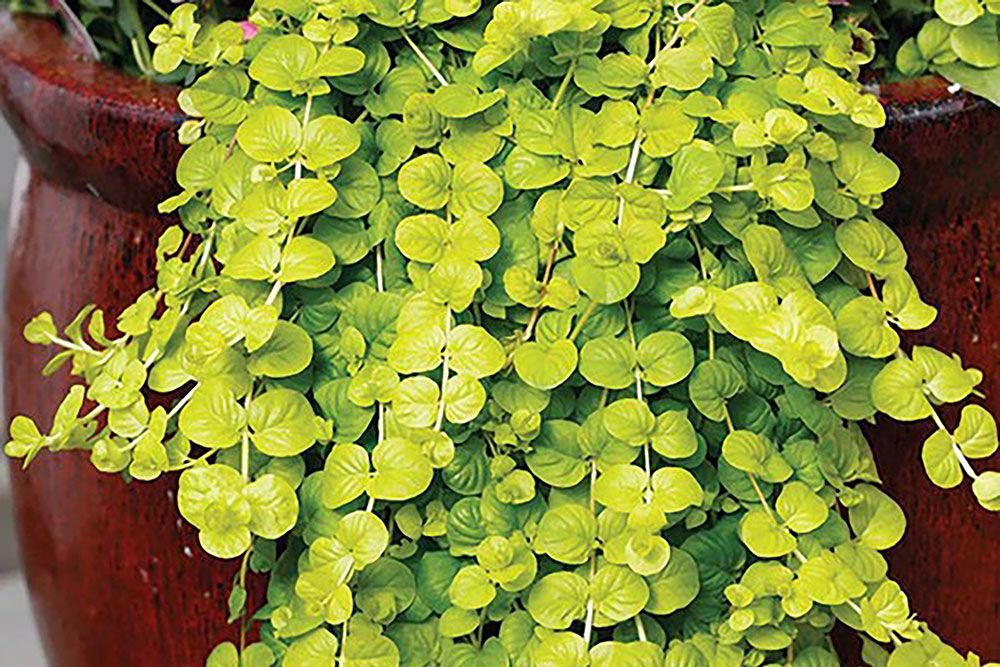Invasive Creeping Jenny invades wetlands

Invasive Creeping Jenny plant is a nasty invader of natural wetland ecosystems
Feature – Invasive Species – October – Focus on Creeping Jenny – Lysimachia nummularia
By Renee Sandelowsky and Helen Varekamp
Renee Sandelowsky and Helen Varekamp are Bayfield residents and local volunteers. They are writing a monthly series of articles, for the Canadian Coalition for Invasive Plant Regulation, about the benefits of planting native species of plants and removing invasive species. This month (October 2025), their focus is the invasive plant Creeping Jenny – Lysimachia nummularia.
Creeping Jenny, also called Moneywort, is native to Europe. It is a long, crawling plant that can spread very tenaciously.
It is often touted as a good ground cover for wet areas, and its trailing foliage is used for decoration in hanging baskets and other planters by some garden centres. Once it is established, it can be hard to get rid of and will crowd out plants that get in its path.
The same properties that make the Creeping Jenny plant an enticing ground cover for gardeners and landscapers turn it into an effective invader in natural wetland ecosystems. It is known to escape from cultivation into forested flood plains and other wetlands, where it often forms dense mats. It is also a prolific producer of seeds. Please do not buy this plant or trade it with your friends.
The plant’s toothless, spade-shaped leaves can vary from green to yellow in colour, based on sunlight exposure. Flowers are yellow with dark red spots. It is often mistaken for Creeping Charlie.
The plant only reaches about 2-4 inches in height but it can grow to be two feet long and has an unusually extensive root system.
- Spread: Creeping Jenny can spread quickly and form dense mats that exclude other plants. It can grow in a variety of light conditions and wet areas.
- Hard to remove: Once established, Creeping Jenny can be difficult to remove completely.
- Out-competes native plants: Creeping Jenny can out-compete native plants for resources.
Creeping Jenny control is not always easy, and it’s not always quick. If the plant is established in your yard, it may take two growing seasons to eradicate it.
How to manage Creeping Jenny
Managing Creeping Jenny is challenging but achievable with persistence and a multi-step approach:
- Manual Removal: Before flowering, small areas can be pulled out by hand or dug out by using a shovel. Check every couple of weeks for new plants emerging, as their roots are very extensive and deep. Do not put plants in the compost or municipal green waste; put in the garbage instead.
- Smothering: Larger areas can be covered with a tarp or cardboard to block sunlight.
- Herbicide Treatment: Alternately, small or large areas can be eradicated by using an herbicide. Use herbicides only as a last resort, following all applicable regulations to minimize environmental harm.
After removal, replant the area with regionally appropriate native plants. This step is essential to prevent reinfestation and to restore ecosystem health. Native plants also attract pollinators and wildlife, improving biodiversity in your garden.
A good choice, as an alternative, would be Canada Anemone – Anemone canadensis.
Learn more and take action
Education is key to combatting invasive plants. Learn to identify invasive species and choose native or non-invasive alternatives for your garden. Focus on managing one or two invasive plants at a time and be patient – successful eradication takes time and persistence.
About the Canadian Coalition for Invasive Plant Regulation
You may ask, why are some garden centres still selling invasive plants since they are so harmful? That’s a good question. That’s also why the Canadian Coalition for Invasive Plant Regulation (CCIPR) wants the federal government to regulate the sale of invasive plants and/or provide labelling and education to inform the public of the negative impacts of these plants.
Some provinces do regulate some invasive species but the rules vary from province to province. For example, Yellow Flag Iris is regulated only in Alberta, British Columbia and Manitoba. The Multiflora Rose is an invasive ornamental plant that appears on lists of invasive plant councils across Canada but it is unregulated in all Canadian provinces.
Individuals can get involved by becoming a CCIPR supporter – free of charge and without obligations. You may visit the CCIPR Get Involved web page to learn more.
Businesses can show their support by becoming a partner and have their logo displayed on the organization’s Partners web page – again free of charge and without obligations.
To learn more, visit:
- Ontario Invasive Plant Council
- Canadian Coalition for Invasive Plant Regulation
- Grow Me Instead Guide